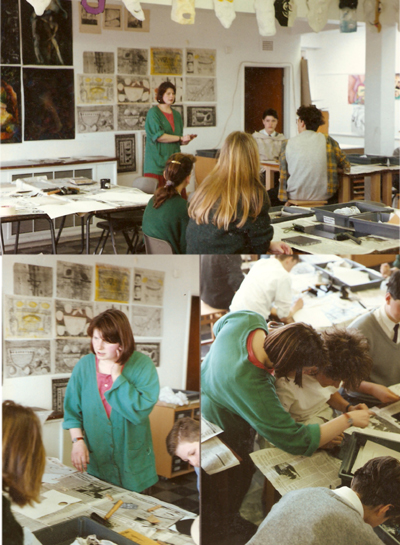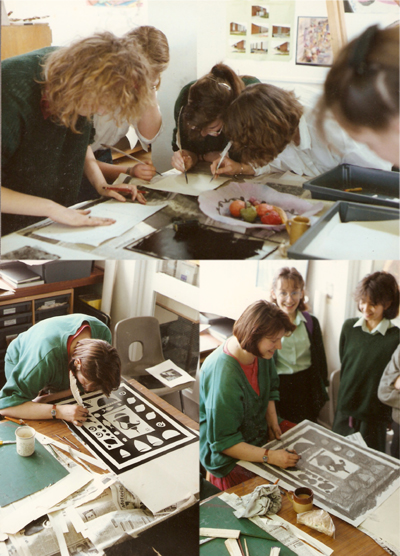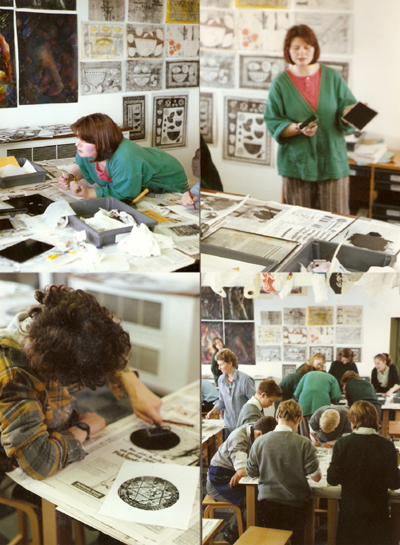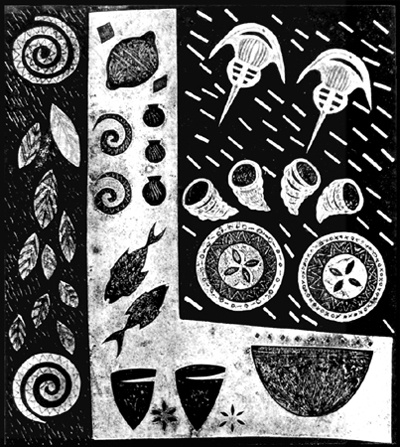| |
Sara
Fairfax |
|
monoprint
residency |
|
>back< |
|
||
 |
Artist
in Residence, 1990, This this was a one week residency that was about sharing my working practice as an artist with a number of Year 8 pupils at The Castle School, Taunton. I was exploring mono-printing techniques using stencils to work with positive and negative space. I had been admiring the still life paintings of an artist friend of mine, Jilly Hartshorn whose work played with the spatial arrangement of still life objects. She would often play with the foreground/background space by paint an entire surface with paint textures and then the still life objects would be defined by painting the space around the still life object. I had also been looking at a lot of indian minature painting, of which was a big influence in my own paintings, drawings and sketchbook work at the time. What I wanted to explore was the use of black and white as figure and ground, as well as simplying the still life forms that exist by using both the postive and negative space. But most af all, I wanted a way of bringing together a collection of objects and images that were personally important for me at the time and to make something of the numberous images that had been surfacing time and time again in my sketchbook work. The pupils were also just beginning to work in print, so for the first part of the week we discovered what was possible together. We started with simply monoprints and developed the process into stages of development. By the end of the week the pupils had learnt to gain control over the process of monoprinting and my prints began to take some shape and became increasingly demanding and complex. Mono-printing for the novice can feel unruly and frustrating and as anyone familiar with the process knows, you only really get one good shot at the final image. By the end of the week I had learnt how to cut incredibly fine A2 sized stencils.These were like delicate Japanese paper cuts, that had to be handled very carefully. The preparation for the print stencils were lengthy; a day or more to design and cut, another half day to plan the stages of the print and the prints themselves took half a day at least, trying to work fast enough to catch the last of the ink before it dried out. I liked discovering the many possibilities of marks that could be made and grasped between when the ink was fresh applied to the plate and point of drying. Many of which I learnt through working with the pupils. At the moment of printing I enjoyed the chase against time. There were beautiful moments of discovery, like the way the crisp edge of the cut stencil gentle embossed the print paper as the lines were transferred from plate to paper. This residency taught me a lot about the fine balance between black/white, positive/negative imagery in design and much of the imagery in these prints where later developed into my linoprints. The pupils gained confidence in the techniques of monoprinting as a way of exploring the potential of their other course work and continued to do so as they undertook G.C.S.E Art & Design in the proceeding years. In the time since these prints were done I have also experiemented with using stencils in the application of charcoal and pastel in landscape work, imaginative drawing and in clay and have taught these techniques in various workshops and residences around the UK as well as using them widely in my own work, particularly in drawing. |
|||||||
 |
||||||||
 |
||||||||
 |
||||||||